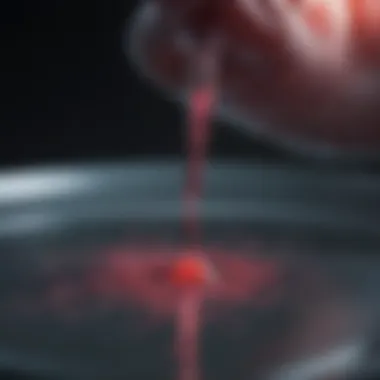Exploring the Efficacy of Fugene Transfection Techniques


Intro
Fugene transfection represents a critical advancement in the field of molecular biology. This technique facilitates the efficient delivery of nucleic acids into various cell types, thereby allowing researchers to manipulate genetic material for a range of applications. Over the years, fugene transfection has gained prominence owing to its unique features, including higher transfection efficiency and lower cytotoxicity compared to traditional methods.
This article aims to present an in-depth overview of fugene transfection, its underlying mechanisms, optimization strategies, and relevant applications. As the landscape of scientific research evolves, understanding the nuances of fugene transfection is crucial for both students and professionals seeking to leverage this technology.
Research Highlights
Key Findings
Fugene transfection is characterized by its versatility, applicable across various cell lines, including hard-to-transfect cells. Key findings highlight that fugene allows for the introduction of plasmid DNA and RNA with remarkable efficiency. In comparative studies, fugene has often outperformed lipofection and electroporation methods in terms of delivery success and safety for the target cells.
Some of the notable findings include:
- Increased transfection rates in both adherent and suspension cells.
- Reduced toxicity levels, maintaining cell viability post-transfection.
- Compatibility with several nucleic acid types, such as siRNA, mRNA, and plasmid DNA.
Implications and Applications
The implications of efficient fugene transfection are substantial, particularly in the fields of gene therapy, vaccine development, and functional genomics. It enables researchers to explore gene functions and interactions at a fundamental level.
Applications of fugene transfection include:
- Gene Knockdown: Utilizing siRNA for targeted gene silencing.
- Gene Editing: Combining with CRISPR technology for precise genetic modifications.
- Protein Expression: Overexpressing proteins for structural biology studies.
By improving gene delivery methods, fugene transfection aids in advancing therapeutic approaches and enhancing our understanding of cellular processes.
Methodology Overview
Research Design
The effective deployment of fugene transfection requires careful planning and systematic experimentation. Researchers need to select appropriate cell lines and optimize various parameters such as the ratio of fugene reagent to nucleic acid, incubation times, and cell densities.
Experimental Procedures
To conduct fugene transfection, the following experimental procedures are typically observed:
- Preparation of cells: Cultivating the target cells to an optimal confluency for transfection.
- Formulation of the transfection complex: Mixing fugene reagent with nucleic acids in a suitable buffer.
- Transfection and incubation: Adding the transfection mix to the cells and allowing sufficient time for uptake.
- Post-transfection analysis: Evaluating transfection efficiency through assays such as qPCR or flow cytometry.
Through adherence to these methodologies, researchers can achieve consistent results and enhance the overall effectiveness of their transfections.
Fugene transfection stands out due to its low toxicity, high efficiency, and flexibility in nucleic acid types, making it indispensable in modern molecular biology.
Understanding Transfection
Transfection is a critical process in molecular biology that allows scientists to introduce nucleic acids into cells. This technique is essential for numerous applications, ranging from basic research to therapeutic development. Understanding transfection is paramount, as it equips researchers with the foundational knowledge needed to manipulate gene expression and develop innovative solutions in biomedical fields.
Definition of Transfection
Transfection refers to the method of deliberately introducing nucleic acids—such as DNA or RNA—into cells. This technique can be accomplished using various methods, including physical, chemical, or biological approaches. By inserting genetic material, researchers can study gene function, plant modifications, or create animal models for disease. Each transfection method has its own advantages and limitations, influencing the choice depending on the specific experimental needs.
Importance in Molecular Biology
The significance of transfection in molecular biology cannot be overstated. It serves as a tool to:
- Understand Gene Function: By introducing different nucleic acids, researchers can observe how changes in gene expression affect cellular behavior.
- Develop Therapeutics: Transfection plays a role in gene therapy experiments, where corrected genes are delivered to patient cells to address genetic disorders.
- Create Biologics: The production of recombinant proteins often relies on successful transfection of host cells.
- Study Gene Regulation: Exploring how genes are turned on or off provides insights into broader biological processes.
By mastering transfection techniques, scientists can enhance their research capabilities and contribute to advances in medicine and genetics.
"Transfection is not merely a tool; it is a bridge to understanding the intricate systems within living organisms."


To sum up, grasping the concept of transfection is fundamental for anyone involved in molecular biology. It lays the groundwork for exploring gene functions, designing experiments, and advancing our knowledge about cellular processes.
Prolusion to Fugene
The exploration of Fugene transfection serves a critical role in modern molecular biology. Understanding its composition and mechanism elucidates why it stands out among various transfection techniques. This section aims to convey the significance of Fugene as a transfection tool and its influence on research methodologies.
Composition of Fugene Reagents
Fugene reagents are meticulously formulated to facilitate effective delivery of nucleic acids into target cells. A typical Fugene reagent consists primarily of three components: lipids, a buffer system, and a stabilizer. The lipids play a crucial role in creating lipid-nucleic acid complexes that are capable of merging with cellular membranes. This interaction is vital for successful nucleic acid uptake.
The buffer system ensures optimal pH and ionic conditions for transfection, enhancing the stability of the complex and the overall efficiency of the process. The stabilizer aids in preserving the integrity of the nucleic acids during transfection. Various formulations may exist for different applications, adapting to the specific cellular environments or experimental goals.
Consider these points about Fugene reagents:
- They provide high transfection efficiency across a range of cell types.
- They exhibit lower toxicity compared to some other transfection methods, improving cell viability post-transfection.
- They are well-suited for both plasmid and RNA delivery.
Mechanism of Action
Fugene's action mechanism primarily revolves around the creation of lipoplexes, which are complexes formed between the lipids and nucleic acids. Upon application, these lipoplexes find their way to the cell surface, where they engage with the lipid bilayer of the cellular membrane. This leads to the fusion of the lipoplexes with the membrane, allowing the nucleic acids to enter the cytosol.
Following entry, the nucleic acids can either migrate to the nucleus for gene expression or partake in the cytoplasmic processes. The efficiency of this mechanism depends on several factors:
- The quality of the Fugene reagent, which influences how well it forms lipoplexes.
- The cell type used, as certain cells can take up nucleic acids more readily than others.
- The nucleic acid type, which may affect transfection success depending on the structural characteristics of the nucleic acid.
"Fugene transfection distinguishes itself through its formulation, allowing for a consistent and optimized transfection process."
In summary, the composition and mechanism of Fugene reagents are pivotal for researchers aiming to effectively implement transfections in their studies. The understanding of these components empowers scientists to optimize protocols and adapt methodologies suitable for their specific cellular and experimental contexts.
Comparative Analysis of Transfection Methods
Analyzing different transfection methods is essential for researchers in the field of molecular biology. Each method carries its own advantages and drawbacks, impacting both the efficiency of gene delivery and the reproducibility of experiments. Understanding these nuances helps scientists to select the optimal technique for their specific experimental aims. This section will focus on two prevalent methods: Lipofection and Electroporation, comparing them to Fugene transfection.
Lipofection vs. Fugene
Lipofection is one of the most widely used methods for delivering genetic material into cells. It employs lipid-based reagents to facilitate the uptake of plasmid DNA into the cells. This method is appreciated for its simplicity and effectiveness in many cell types. However, it also presents limitations, particularly regarding cytotoxicity and efficiency in hard-to-transfect cells.
In contrast, Fugene offers a more tailored approach. The advantages of Fugene over lipofection include a lower cytotoxicity profile and a broader application range across various cell types. Researchers often choose Fugene when working with difficult cell lines, such as primary cells or stem cells, that are more resistant to standard transfection techniques. Evidence suggests that Fugene can achieve higher transfection efficiencies in many cases, making it preferable for applications requiring precise gene expression control.
- Efficiency: Fugene generally achieves higher transfection rates than lipofection, especially in demanding cell types.
- Cytotoxicity: Lipofection can lead to increased cell death compared to Fugene.
- Application Range: Fugene is often more versatile across a range of cell lines.
These distinctions are critical for researchers selecting protocols and optimizing experiments to achieve desired outcomes.
Electroporation and Its Limitations
Electroporation involves applying an electrical field to cells, creating temporary pores in the cell membrane. This method allows for a direct introduction of nucleic acids into the cell. It has shown great potential, particularly in hard-to-transfect cell lines, and is often used in contexts such as transgenic animal development and vaccine research. However, several limitations exist.
Firstly, the method can induce significant cellular stress, leading to high rates of cell death if not precisely controlled. Optimizing the parameters, such as voltage and pulse duration, can be crucial but is not always straightforward.
Additionally, electroporation requires specialized equipment and training, which may not be feasible in all laboratory settings. The procedural complexities can deter some researchers from utilizing this method altogether, especially in high-throughput applications or routine experiments.
"Understanding the various transfection methods helps ensure researchers can choose the one that aligns best with their experimental design and desired outcomes."
In summary, the comparative analysis of transfection methods, specifically lipofection and electroporation versus Fugene, reveals the diverse tools available for gene delivery. Researchers must weigh these elements carefully to achieve optimal experimental results.
Optimizing Fugene Transfection Protocols
Optimizing Fugene transfection protocols is fundamental for enhancing the efficiency and reliability of gene delivery in experimental settings. The choice of protocol can significantly influence outcomes in cellular responses, gene expression levels, and overall experimental viability. A well-optimized transfection process ensures reproducibility and facilitates meaningful comparisons across studies. With various parameters to consider, understanding how to optimize these factors can lead to more robust experimental designs.
Cell Line Selection
The selection of the appropriate cell line is critical in any transfection experiment. Different cell lines exhibit varied susceptibility to transfection agents like Fugene. Primary and established cell lines may respond differently to the same transfection protocol. Understanding the specific characteristics of the target cell line, such as growth rate, size, and membrane rigidity, can help tailor the Fugene transfection protocol accordingly.


When choosing a cell line, researchers should also consider the purpose of the transfection. For instance, cancer cell lines might offer a different efficiency compared to fibroblast or neuronal cell lines. Additionally, some cell lines may require different growth conditions or media formulations, which can affect transfection success. Prioritizing well-characterized lines can help mitigate variability and increase reproducibility.
Nucleic Acid Quantity
The quantity of nucleic acid used in transfection significantly impacts the overall efficiency. Insufficient amounts may lead to weak expression signals, while excessive quantities can induce cellular stress or toxicity, ultimately diminishing the viability of the cells. Determining the optimal amount involves a balance, often requiring preliminary titration experiments.
It is advisable to start with a range of nucleic acid concentrations, assessing the effects on transfection efficiency and cell viability. For instance, if using plasmid DNA, quantities typically range from 0.5 to 5 micrograms per well, but the exact requirement depends on the cell type and the scale of the experiment.
Reagent-to-DNA Ratio
The ratio of Fugene reagent to nucleic acid is another crucial factor in transfection optimization. An improper ratio can lead to suboptimal transfection performance. A general rule is to maintain a 2:1 ratio of Fugene reagent to DNA for many cell types, but this may vary based on experimental conditions and cell line characteristics.
To find the best ratio, experimenting with a gradient of Fugene reagent concentrations is recommended. A systematic approach will help ascertain the ideal conditions that yield maximum transfection efficiency while maintaining cell health.
Key Takeaway: Optimizing parameters such as cell line choice, nucleic acid quantity, and reagent-to-DNA ratio is essential for achieving successful Fugene transfection, leading to more reliable experimental outcomes.
Applications of Fugene Transfection
Fugene transfection presents a versatile platform with numerous applications within molecular biology and biotechnology. Its ability to deliver nucleic acids effectively into various cell types underscores its importance. Researchers across disciplines rely on Fugene transfection to achieve specific goals, making it a critical tool in the genetic engineering toolkit.
Gene Expression Studies
One primary application of Fugene transfection is in gene expression studies. This technique allows researchers to introduce plasmids and other nucleic acids into cells, leading to the robust expression of target genes. Understanding gene function is essential in molecular biology, and transfection facilitates this by enabling the study of gene regulation, protein function, and interaction networks.
Fugene's unique composition enhances transfection efficiency, which is vital for studies that require high levels of gene expression. The ability to optimize parameters, such as reagent-to-DNA ratio, allows for tailoring experiments specific to cell types, maximizing the yield of expressed proteins.
siRNA and shRNA Delivery
Fugene transfection is particularly effective for delivering small interfering RNA (siRNA) and short hairpin RNA (shRNA). These RNA molecules play crucial roles in gene silencing and regulation. The ability to downregulate gene expression provides significant insights into gene functions and pathways.
Accurate delivery of siRNA and shRNA is essential for achieving targeted knockdown. Fugene transfection has demonstrated superior performance compared to other methods, ensuring higher silencing efficiency and lower cytotoxicity. This is particularly beneficial in therapeutic applications, where precision is paramount.
Protein Production
Another significant application of Fugene transfection is in protein production. Researchers utilize this method to produce recombinant proteins in various cell types. Whether for therapeutic development or for studying protein function, efficient transfection translates into higher protein yields and better characterizations.
Proteins produced through Fugene transfection can be used for multiple purposes, such as in drug development, vaccine production, or even as research tools. The technique’s adaptability to different cell lines makes it a favored choice for protein expression in both prokaryotic and eukaryotic systems.
"By leveraging the capabilities of Fugene transfection, researchers can effectively bridge gaps in information, paving the way for new discoveries in genetic research."
Advanced Techniques in Transfection
In the arena of molecular biology, advancing techniques in transfection are central to enhancing the efficacy of gene delivery systems. As the demand for precise and scalable methods grows, focus has shifted towards optimizing tools like Fugene for a wide range of applications. Advanced techniques can lead to improved cell viability, greater transfection efficiency, and more specific targeting of genes, making them indispensable in both research and therapeutic settings.
Several critical factors should be considered when discussing advanced transfection techniques. Optimizing reagent formulation, understanding cellular microenvironments, and specified target areas within cell types are important elements that can significantly improve results.
Use of Plasmids in Fugene Transfection
Plasmids play a vital role in Fugene transfection, serving as vectors to introduce foreign DNA into target cells. The design of plasmids can greatly influence transfection outcomes. Generally, plasmids are engineered to carry specific genetic segments that researchers aim to express in host cells. The simplicity in delivering plasmids with Fugene stems from its ability to facilitate the uptake of nucleic acids through its proprietary formulation.
- Customizable Vector Design: Researchers can customize plasmid vectors to incorporate specific promoters, markers, and regulatory elements that enhance expression.
- Multiple Applications: Plasmids can be used for gene expression studies, protein production, and the delivery of RNAi molecules.
By embracing advanced plasmid design, scientists maximize their ability to achieve the desired gene expression or silencing effects.
Quantitative Analysis of Transfection Efficiency
Quantitative analysis is fundamental to understanding the effectiveness of any transfection protocol. In the context of Fugene transfection, analyzing efficiency involves measuring how many cells have successfully taken up the introduced nucleic acids and their subsequent expression levels.
- Common Metrics: Efficiency can be quantified using several metrics such as:
- Fluorescence microscopy: This method evaluates cells that express fluorescent markers following transfection.
- Flow cytometry: Provides precise quantification of transfected cells, enabling a nuanced understanding of efficiency across large populations.
- Real-time PCR: This technique can determine gene expression levels, verifying the functional success of transfection.


Understanding and measuring transfection efficiency guides researchers in refining their methodologies and adjusting parameters as needed. Ultimately, a robust evaluation of transfection efficiency contributes significantly to the advancement of gene delivery technologies.
Limitations of Fugene Transfection
Fugene transfection has gained popularity due to its effectiveness in delivering nucleic acids across various cell types. However, like any method, it has its limitations. Understanding these limitations is crucial for researchers when planning experiments and interpreting results.
Cell Type Specificity
One significant limitation of Fugene transfection is its cell type specificity. Different cell lines respond variably to transfection methods, and Fugene is no exception. For instance, while some adherent cell lines may achieve high transfection efficiency, others may show minimal uptake of nucleic acids. This variability can make it challenging to extrapolate results across different cell types. Some cell lines are particularly resistant to transfection, which means that researchers must carefully consider whether Fugene is suitable for their cell of interest.
To optimize transfection for various cells, researchers often need to conduct preliminary experiments to assess Fugene’s efficacy. This can involve testing different reagent concentrations, incubations times, or alternative transfection reagents. Utilizing controls in such experiments is essential to evaluate the relative success of Fugene transfection in each specific cell line.
Potential for Cytotoxicity
Another critical limitation is the potential for cytotoxicity. Fugene, while generally considered less toxic than other transfection reagents, can still induce harmful effects on cells depending on several factors, such as the concentration of the reagent and the type of nucleic acid being delivered. High doses can lead to significant cell death or altered cell metabolism, which may skew experimental results.
Researchers must thus balance transfection efficiency with cell viability, ensuring that the concentrations used do not adversely affect the overall health of the cells. It is recommended to perform assays to assess cytotoxicity alongside transfection experiments. Common assays include the MTT or Trypan Blue exclusion test, which provide insights into the impacts of Fugene on cell survival. If cytotoxicity is observed, adjustments can be made to reduce the concentration of Fugene or to consider alternative delivery systems that may pose less risk to cell viability.
It is vital to implement controls and assays to evaluate both transfection efficiency and the health of the cells during Fugene transfection experiments.
In summary, while Fugene transfection offers many advantages, understanding its limitations related to cell type specificity and potential cytotoxicity is essential for optimizing experiments and ensuring valid results. This awareness allows for more informed choices in transfection methodology, especially when addressing specific research questions.
Future Directions in Transfection Technology
The exploration of future directions in transfection technology is crucial for advancements in genetic research and therapeutic interventions. As the demand for more efficient and versatile transfection methods increases, it becomes essential to understand the evolving landscape of these technologies. This section will discuss the significance of emerging trends and integration with innovative approaches, particularly focusing on how these developments can address current limitations and expand the possibilities in gene therapy.
Emerging Trends in Gene Delivery
Recent advancements in gene delivery have led to a variety of emerging trends that promise to transform the field. One notable trend is the increased focus on nanoparticle-based delivery systems. These nanoparticles can encapsulate nucleic acids, protecting them from degradation while enhancing their cellular uptake.
Moreover, there is a growing interest in virus-like particles (VLPs), which mimic natural viral structures for more efficient transport of genetic material. The use of exosome-mediated delivery also shows promise, capitalizing on the body’s own mechanisms for intercellular communication to introduce nucleic acids into target cells with minimal immune response.
Key advantages of these emerging methods include:
- Enhanced specificity for target cells
- Reduced off-target effects
- Improved transfection efficiency, especially in challenging cell types
These trends are likely to continue evolving, emphasizing the need for ongoing research and development in gene delivery systems.
Integration with CRISPR Technology
The integration of CRISPR technology with transfection methods is another exciting area for future exploration. CRISPR-Cas9 has revolutionized genetic editing by providing precise and targeted modifications to the genome. However, the effective delivery of CRISPR components remains a challenge.
By combining Fugene transfection with CRISPR, researchers can enhance the delivery of CRISPR components, such as guide RNAs and Cas9 proteins, into cells. This integration could significantly increase the precision and efficiency of gene editing.
Considerations for integration include:
- Ensuring that the transfection method used does not induce additional cellular stress.
- Optimizing the ratio of CRISPR components in relation to Fugene reagents to maximize editing efficiency.
- Evaluating the long-term effects of CRISPR delivery on cell viability and function.
The synergy between these technologies can pave the way for groundbreaking therapies, addressing genetic disorders at their molecular roots.
"Emerging trends in gene delivery and the integration of CRISPR technology stand to redefine the possibilities in genetic research and therapeutic applications."
The End
The conclusion of this article serves as a critical synthesis of the fundamental concepts surrounding Fugene transfection. The integration of various elements discussed throughout the text reinforces the importance of this method in contemporary molecular biology research. By summarizing the key points, the conclusion provides not just closure but also clarifies the significance of Fugene transfection in practical applications.
Key takeaways include:
- Understanding the Mechanism: Insights into the mechanism of action for Fugene reagents foster a deeper comprehension of how nucleic acids are efficiently delivered into cells.
- Optimizing Protocols: A discussion on optimization techniques equips researchers with knowledge on how to enhance transfection efficacy, thereby improving experimental outcomes. This is particularly valuable when dealing with diverse cell lines and desired gene targets.
- Addressing Limitations: By acknowledging the limitations of Fugene transfection, such as cell type specificity and potential cytotoxicity, researchers can better plan their experiments, making informed decisions that lead to success in gene delivery.
- Future Directions: Highlighting the emerging trends and potential integration with CRISPR technology lays the groundwork for potential future advancements in gene delivery systems. This aspect is especially relevant in an era where precision medicine and gene editing are gaining momentum.
"Fugene transfection represents a reliable bridge connecting basic research and potential therapeutic applications."
This perspective not only emphasizes the role of Fugene in scientific inquiry but also the transformative potential of the technique as we advance into new realms of genetic understanding and application.
Summary of Key Points
- Fugene transfection is a powerful method for nucleic acid delivery.
- Mechanism of action consists of lipofection principles.
- Optimization strategies include careful selection of cell lines and tweaking reagent-to-DNA ratios.
- Applications span gene expression studies, protein production, and RNA delivery.
- Awareness of limitations aids in planning experiments efficiently.
- Future research may lead to significant innovations in gene delivery practices.



